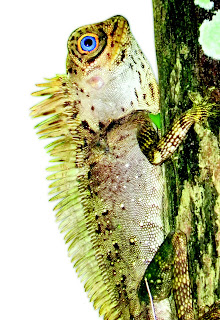 |
| Caught in the act:Bornean horned frogs mate in the night Photo by Yeo Siew Teck |
Teck
By Mary Margaret
The night comes early to the lowland dipterocarp forest of Gunung Gading National Park. The tree-clad mountain slopes stop the fading daylight and long shadows play on the forest floor. The creatures of the day hunker down and the night ones emerge to rule the dark hours.
The brown blue-eyed angle- headed lizard (Gonocephalus liogaster) with a crest running from its head down its back lifts its head. The herd thunders past. It hunkers down along the stem of the palm and hopes the clumsy humans would go quickly; with his hiding place intact. One, two, three... only a few more...
“Hey, did you see the lizard?” Dazzling lights flare into the night sky and into the lizard’s eyes. The motionless lizard plays dead – paralysed. How the lizard wishes the human herd would move on, but they hover.
One by one they leave, and with a final flash, the quiet returns to the blue-eyed angle-headed lizard’s world so that it can continue to hunt insects through the night after it recovers from the shock. The light had hurt. It clings to the stem waiting for sight to return. The spiders spinning their webs around their prey stop as the lights flicker across the night sky. The swaying lights sweep the treetops and forest floor in search of the reflection from the eyes of night-loving animals. The herd stumbles on over the rocks and boulders along the narrow, poorly marked trail.
A few frogs and some spiders are caught and then along the edge of a slow moving forest stream that courses along moss- covered boulders there is sudden quiet.
The Bornean horned frog (Megophrys nasuta) has come to the water’s edge to mate and lay its eggs in a safe place. The emergence of the large human herd is neither expected nor wanted. The speckled brown frog, when still, merges into the leaf litter and hunts by stealth as its prey of scorpions, centipedes and insects fall into its trap.
Thrashing about in the jungle heralds the arrival of the unwanted human visitors with
searching out night-loving inhabitants. The frogs fall victim – unable to move. The small male is clamped to the back of the much larger female; escape is not possible.
Excitement flows in waves through the crowd. The wide mouth Bornean horned frog blends imperceptibly into the leaf covered forest floor and despite being relatively common is rarely seen and even more rarely observed mating.
“This is a first.” The group stands around. “These are forest frogs and do not have webbing on their toes. They hunt along the forest floor up to about 1,600 metres. Despite being common, human visitors generally miss them as they hide in the litter.” The crowd surges forward while flashing lights and observing.
“This species is not endangered, but other frogs are. Frog populations have declined in many places around the world.
In Borneo each species of frog has adapted to a different habitat and if this particular niche disappears, it is likely that there would be a drop in population.” The waning
moonlight shadows the frogs as nature takes its course and the humans move their weary bones home. They have seen and heard and learnt much from the glaring lights natural world; no doubt they are more comfortable in the lighted world.
NTENSE EYES: A blue-eyed angle-headed lizard clings to a tree. — Photo by Robert Yeoh
Members from the Kuching Branch of the Malaysian Nature Society visited Gunung Gading National Park on Jan 22-23 and the night walk was an intense learning experience.


No comments:
Post a Comment